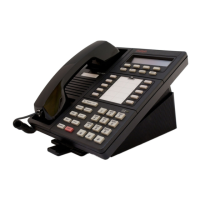MERLIN LEGEND Communications System Release 6.1
Pocket Reference
555-661-116
Issue 1
August 1998
Page 10
Release 5.0 Enhancements (June, 1997)
the handset at the HotLine extension, the telephone automati-
cally dials the inside extension or outside telephone number
programmed as the first Personal Speed Dial number (code 01)
for the extension. At HotLine extensions, calls cannot be trans-
ferred, put on hold, or conferenced.
Personal Speed Dial codes can be programmed at the exten-
sion prior to HotLine assignment (a system programming func-
tion). Alternatively, a Personal Speed Dial code can be
programmed from the single-line telephone after HotLine opera-
tion is assigned. However, because of security considerations,
this is a one-time opportunity. Once the Personal Speed Dial
number is programmed, any changes to it or any other exten-
sion programming must be performed using centralized tele-
phone programming.
Any type of inside or outside line that is normally available to a
single-line telephone can be assigned to a HotLine extension.
Generally, the HotLine telephone does not receive calls, and its
line should be set to No Ring.
SECURITY ALERT:
!
A HotLine single-line telephone accesses a loop-start line,
the line should provide and be programmed for Reliable
Disconnect. If it is not, a caller may be able to stay on the
line after the initial call and access an outside line.
■ Call Center Enhancements. Release 5.0 and later systems
include Group Calling features to enhance call center operation.
— Most Idle Hunt Type. In addition to the Circular (factory set-
ting) and Linear hunt types supported in earlier releases, a
third hunt type distributes calling group calls in an order
based on which agent has waited the longest since transfer-
ring or hanging up on an incoming calling group call. For
some applications, this hunt type is more efficient than the
circular type because it takes into account the varying dura-
tion of calls. The system distributes calls based on when an
agent last completed a call, not on when he or she last
received one. This hunting method ignores non-calling group
calls. For example, if an agent transfers a call that arrived on
a line not assigned to the calling group, the calling group
member’s most-idle status is unaffected.
— Secondary Delay Announcement Device. The system
manager can designate an extension for an optional second-
ary delay announcement device in addition to the single
device for each group that is available in Release 4.2 and
earlier systems. One device is the primary device and oper-
ates in the same fashion as a single delay announcement
device, playing once, as soon as it is available, for the caller
who has waited the longest for a calling group agent. If a sec-
ondary announcement device is used, it can be set to repeat
or play only once for each caller, the factory setting. The sys-
tem manager programs the time (0-900 seconds) between
announcements. This setting controls both the interval
between primary and secondary announcement and the
interval between repetitions of the secondary announcement
if it is set to repeat.

